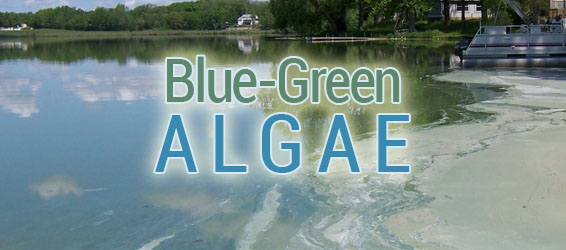- Business & Agriculture
- Residents
- Government
- Education
- Taxes & Finance
- Visiting & Playing
- Family & Health

Welcome
The Indiana Department of Environmental Management (IDEM), the Indiana Department of Natural Resources (DNR), the Indiana State Department of Health (ISDH), and the Board of Animal Health (BOAH) are working to provide information about blue-green algae, also known as cyanobacteria, in our lakes.
Algae are commonly found in Indiana lakes and streams without concern, however the concentrated presence of blue-green algae can be linked to some adverse health effects. Factors promoting algal growth include sunlight, warm weather, low turbulence, and nutrient sources, such as phosphorus and nitrogen. Phosphorous is particularly important in fueling cyanobacteria growth. Often nutrient inputs come from nonpoint source pollution, but fortunately, there are many ways to reduce or stop nonpoint source pollution, many of which are simple things we can do right in our own backyards.
This website will be updated weekly during the sampling season to provide information about blue-green algae levels at the DNR lakes that IDEM samples and the Citizen Energy reservoirs in central Indiana. The IDEM video, Sampling Blue-green Algae, explains how IDEM staff samples the DNR swimming beaches.
You can also check the status of the DNR lakes that IDEM samples at the DNR website for the specific property. This update may also include results for other lakes sampled by other entities wishing to post on this site. You will find links to IDEM’s sampling results and laboratory tests as well as links to other websites such as the World Health Organization, the USGS Kansas Water Science Center, and assorted information available through other states.
Indiana Reservoir and Lake Update
September 1, 2016
Blue-green algae sampling season has now ended. IDEM began blue-green algae sampling the week of May 26 and ended the week of August 29. IDEM samples for blue-green algae and analyzes those samples for the type and quantity of blue-green algae present and for the following toxins which may be produced by certain types of blue-green algae: microcystin, cylindrospermopsin (only done if species that produce it are present) and anatoxin-a. For protection of human health from exposure to the algae and any of the toxins, Indiana will use the World Health Organization (WHO) guideline level of 100,000 cells/ml or a microcystin toxin level of 6 parts per billion (ppb) for a Recreation Advisoryand Caution, respectively. Beaches will be closed if microcystin toxin reaches 20 ppb. The WHO has not set guideline values for cylindrospermopsin or anatoxin-a. Indiana will use 5 ppb of cylindrospermopsin and 80 ppb of anatoxin-a for a Recreation Caution, consistent with the state of Ohio recommendations. Toxin results will be posted if they meet those threshold numbers. Exact cell counts and toxin levels can be found in the Test Results section of the web site. Swimming areas will stay on the High Cell Count Alert until the cell counts fall below 100,000.
IDEM Sampling Results - High Cell Count Recreation Advisory
- Brookville Lake - Mounds State Recreation Area
- Brookville Lake - Quakertown State Recreation Area
- Cecil M. Harden Lake (Raccoon Lake) - Raccoon State Recreation Area
- Hardy Lake - Hardy Lake State Recreational Area
- Mississinewa Lake - Miami State Recreation Area
- Monroe Lake - Fairfax State Recreational Area
- Monroe Lake - Paynetown State Recreational Area
- Potato Creek State Park - Worster Lake
- Salamonie Lake - Lost Bridge West SRA
- Whitewater Lake - Whitewater Memorial State Park
- Ferdinand State Forest Lake - Beach at Ferdinand State Forest Lake
IDEM Sampling Schedule
August 15
- Potato Creek State Park - Worster Lake
- Mississinewa Lake - Miami State Recreation Area
August 16
- Salamonie Lake - Lost Bridge West SRA
August 22
- Monroe Lake - Fairfax State Recreation Area
- Monroe Lake - Paynetown State Recreation Area
- Starve-Hollow State Recreation Area
- Deam Lake State Recreation Area
- Hardy Lake State Recreation Area
August 23
- Cecil M. Harden Lake (Raccoon Lake) - Raccoon State Recreation Area
- Whitewater Lake at Whitewater Memorial State Park
- Brookville Lake - Mounds State Recreation Area
- Brookville Lake - Quakertown State Recreation Area
August 29
- Mississinewa Lake - Miami State Recreation Area
- Worster Lake - Potato Creek State Park
August 30
- Sand Lake - Chain O'Lakes SP
- Salamonie Lake - Lost Bridge West SRA
- Lake James - Pokagon State Park
- Lake James – Pokagon State Park Inn
ISDH cautions Hoosiers of possible high levels of blue-green algae at many of Indiana's reservoirs and lakes. Swimmers and boaters should be careful in all recreational waters during this time of the year. Precautionary measures include avoiding contact with visible algae and swallowing water while swimming. Take a bath or shower with warm, soapy water after coming in contact with water in ponds and lakes, especially before preparing or consuming food. Pets and livestock should also not be allowed to swim in or drink untreated water from these sources. Exposure to blue-green algae during recreational activities such as swimming, wading, and water-skiing may lead to rashes, skin, eye irritation, and other uncomfortable effects such as nausea, stomach aches, and tingling in fingers and toes. If you should experience any symptoms after water recreational activities, please contact your doctor.
Livestock, pets and wild animals can be poisoned by the toxins produced by some algal blooms. Small animals can ingest a toxic dose quickly. Dogs are particularly susceptible to blue-green algae poisoning because the scum can attach to their coats and be swallowed during self-cleaning. Clinical signs of blue green algae poisoning in animals include vomiting, diarrhea, decreased appetite, weakness, seizures and sudden death, especially in livestock. If you see a blue-green algae bloom in the water or where you visit, do not allow pets or livestock swim in or drink from areas where blooms are seen. If pets swim in scummy water, rinse them off with soap and water immediately to remove the toxin. Do not let them lick the algae off their fur. Direct livestock to water sources away from algal infected waters. If your animal shows any of the clinical signs listed above, contact your veterinarian immediately.
- More information is available on the Indiana Board of Animal Health website.




